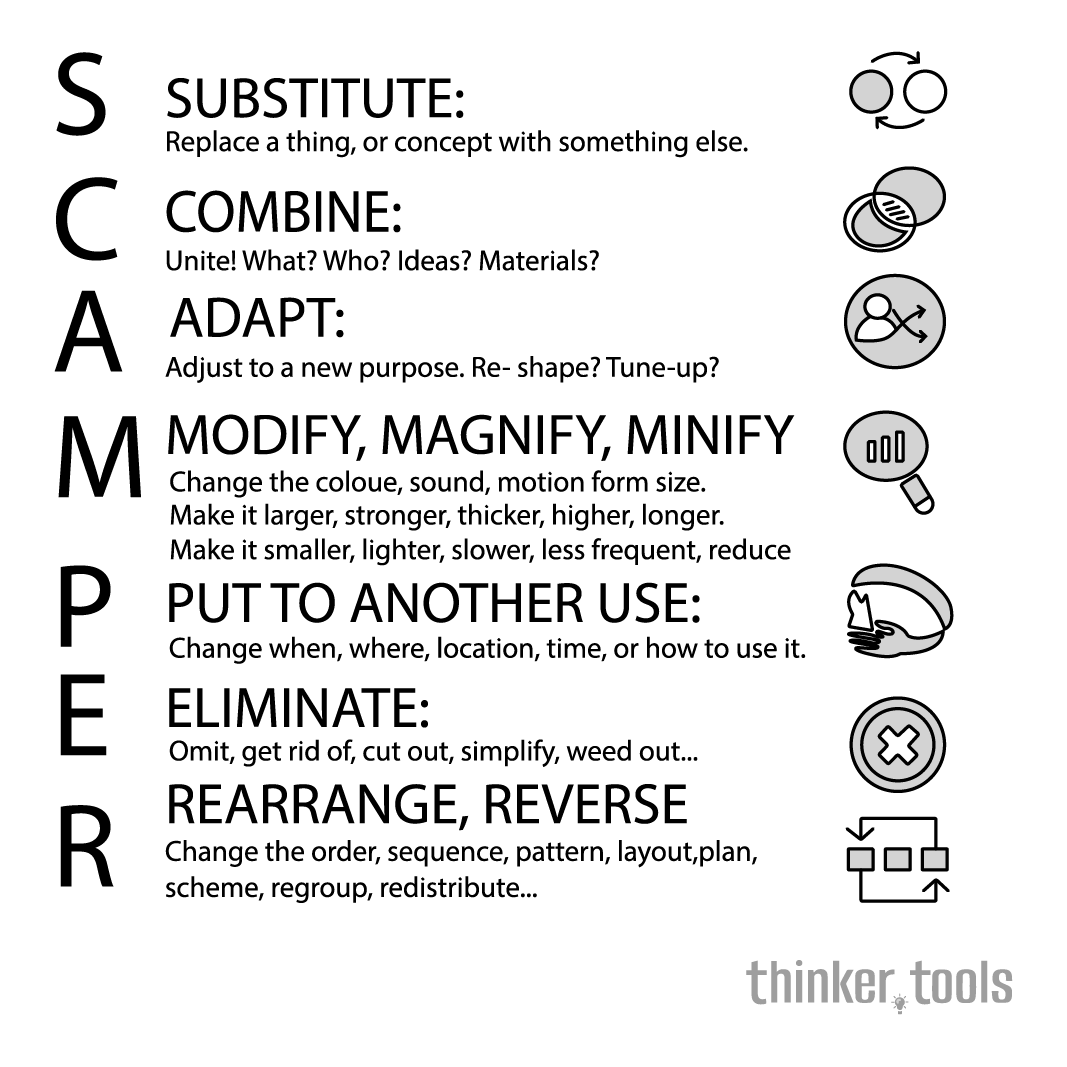
What is SCAMPER?
SCAMPER is an acronym representing seven creative thinking strategies: Substitute, Combine, Adapt, Modify/Magnify, Put to another use, Eliminate, and Reverse/Rearrange. Each letter guides you through a different lens for examining problems, products, or processes, helping you generate innovative solutions and fresh perspectives.
The History Behind SCAMPER
The SCAMPER technique evolved from the work of advertising executive Alex Osborn, who created brainstorming in the 1940s. Bob Eberle later refined Osborn's checklist into the memorable SCAMPER acronym in 1971, making it accessible to educators, business professionals, and creative thinkers worldwide. This transformation from a complex checklist to a simple mnemonic device revolutionized how people approach creative problem-solving.
How to Use SCAMPER Step by Step
1. Define Your Challenge
Start by clearly identifying what you want to improve, create, or solve. Write it down as specifically as possible.
2. Apply Each SCAMPER Prompt
Work through each letter systematically:
S - Substitute: What can you substitute? Consider materials, processes, people, or approaches.
- "What if we used digital instead of paper?"
- "Could we replace this step with something simpler?"
C - Combine: What can you combine or bring together?
- "Can we merge these two features?"
- "What if we combined this with another product?"
A - Adapt: What can you adapt or borrow from elsewhere?
- "How do other industries solve this?"
- "What existing solution could we modify?"
M - Modify/Magnify: What can you emphasize, magnify, or minify?
- "What if we made it twice as large?"
- "Could we exaggerate this feature?"
P - Put to Another Use: How can this be used differently?
- "Who else could benefit from this?"
- "What other problems could this solve?"
E - Eliminate: What can you remove or simplify?
- "What if we removed this feature entirely?"
- "Which steps are unnecessary?"
R - Reverse/Rearrange: What can you reverse or rearrange?
- "What if we did the opposite?"
- "Could we change the sequence?"
3. Document All Ideas
Write down every idea, no matter how unusual. The goal is quantity over quality initially.
4. Evaluate and Refine
After generating ideas through all seven prompts, review and combine the most promising concepts.
Practical Examples
Product Innovation: A coffee shop owner uses SCAMPER to innovate their menu:
- Substitute: Replace dairy with oat milk options
- Combine: Create coffee-smoothie hybrids
- Adapt: Borrow tea ceremony concepts for coffee service
- Modify: Offer extra-large family-size drinks
- Put to another use: Use coffee grounds for garden fertilizer sales
- Eliminate: Remove complicated drinks to speed service
- Reverse: Serve dessert first with coffee pairings
Process Improvement: A teacher applies SCAMPER to online learning:
- Substitute: Replace lectures with interactive videos
- Combine: Merge subjects for interdisciplinary projects
- Adapt: Use gaming elements for engagement
- Modify: Extend successful activities, shorten others
- Put to another use: Turn assignments into peer-teaching opportunities
- Eliminate: Remove redundant assessments
- Reverse: Let students create quiz questions
Benefits and Life Impact
SCAMPER transforms creative thinking from an intimidating, abstract process into a systematic approach anyone can master. By providing structure to creativity, it:
- Overcomes creative blocks by offering multiple perspectives when you're stuck
- Democratizes innovation by making creative thinking accessible to everyone
- Accelerates problem-solving through systematic exploration of possibilities
- Builds creative confidence by providing a reliable process for generating ideas
- Enhances collaboration by giving teams a common creative language
Whether you're redesigning a product, improving a process, or seeking personal growth, SCAMPER provides a reliable pathway to innovative solutions. Its structured approach means you'll never face a blank page wondering where to start—instead, you'll have seven powerful strategies ready to unlock your creative potential.